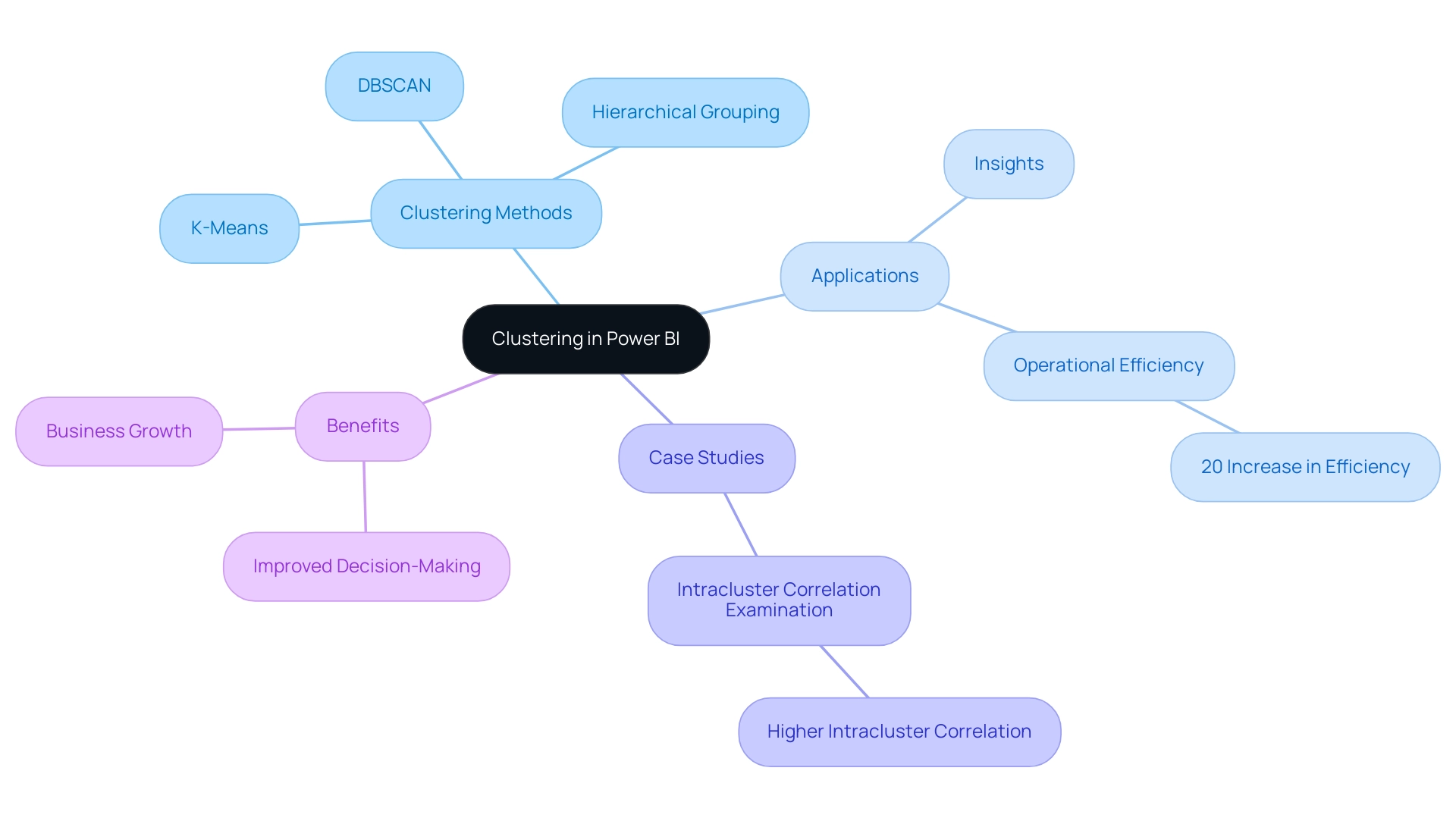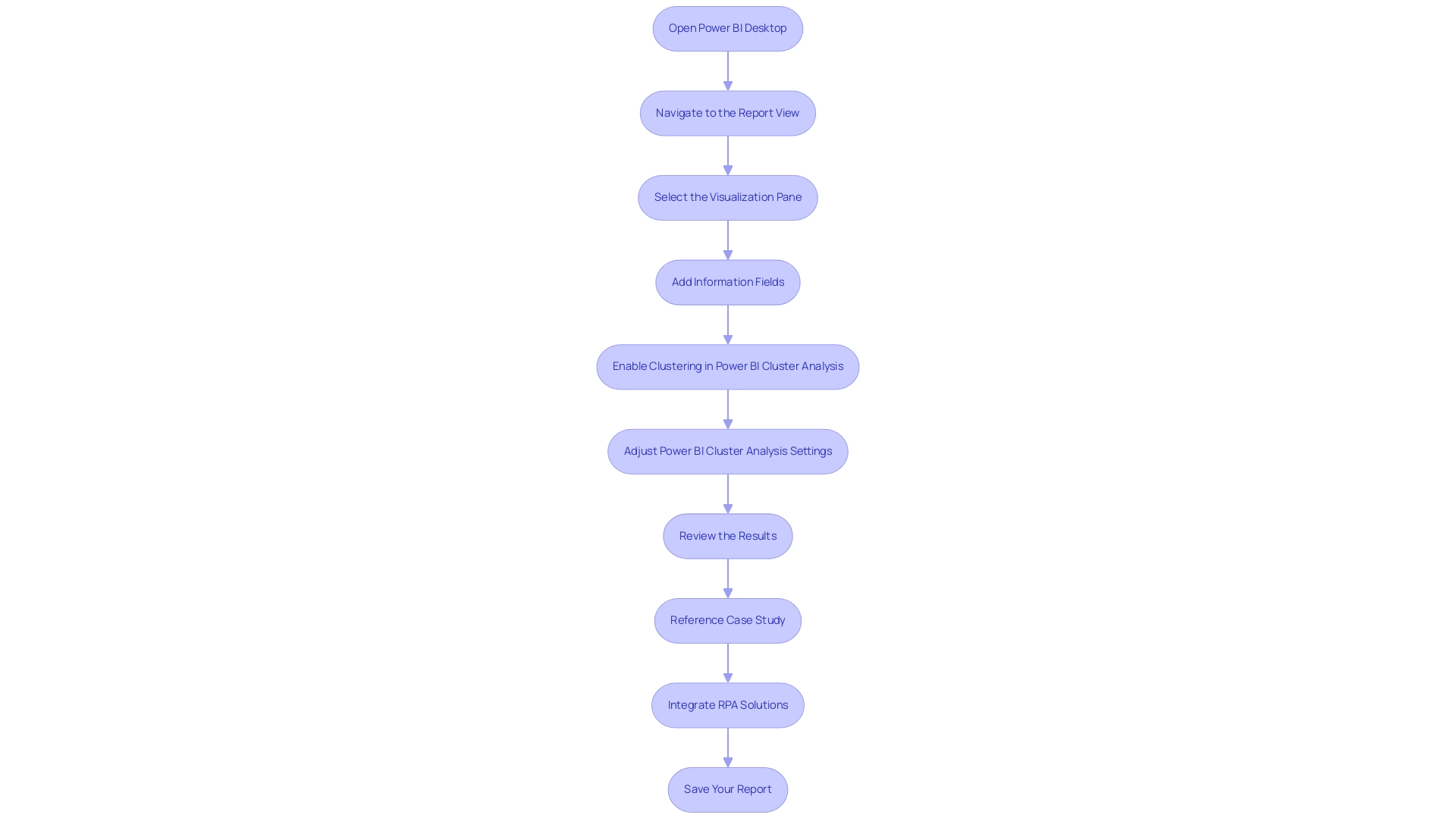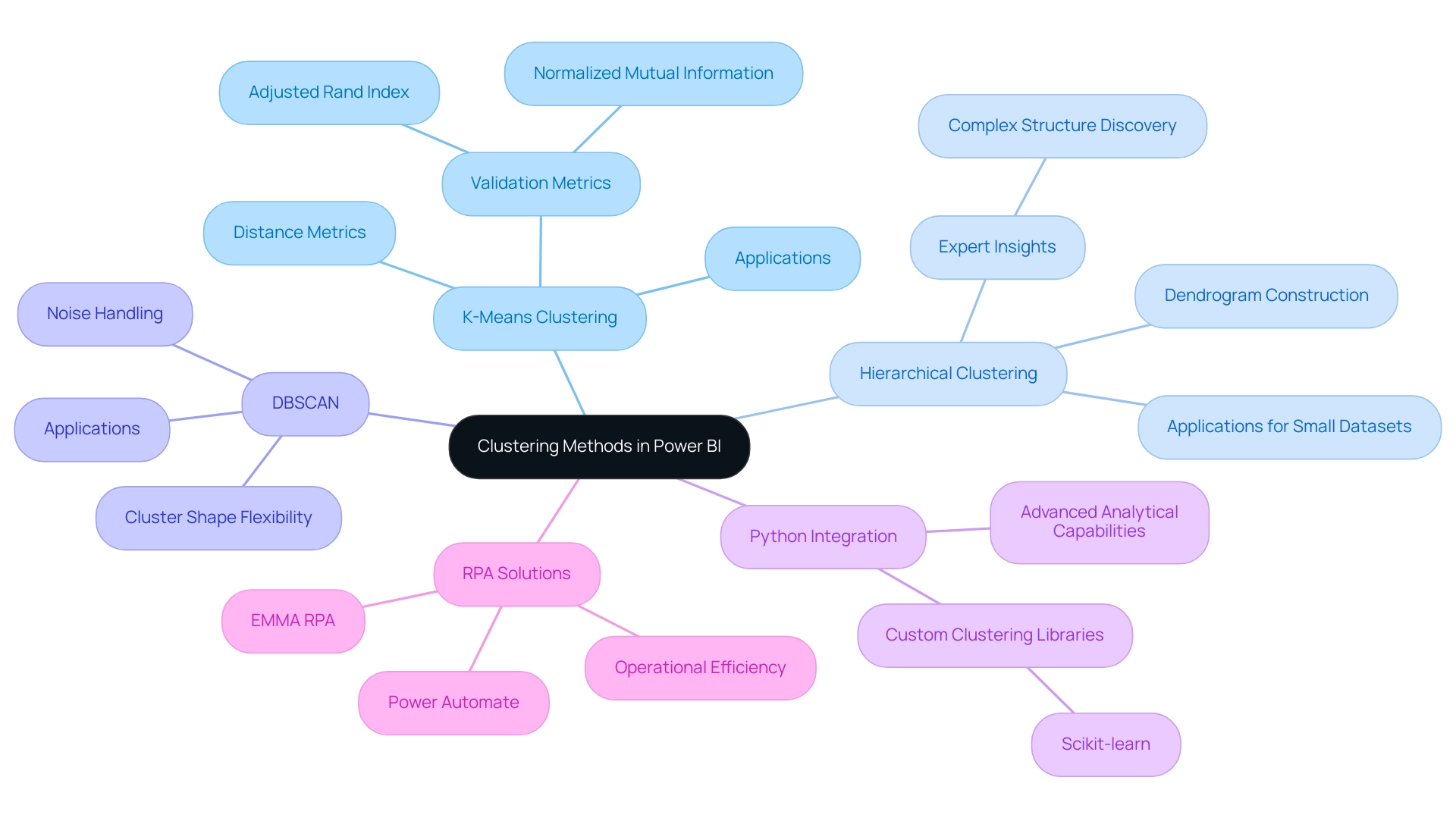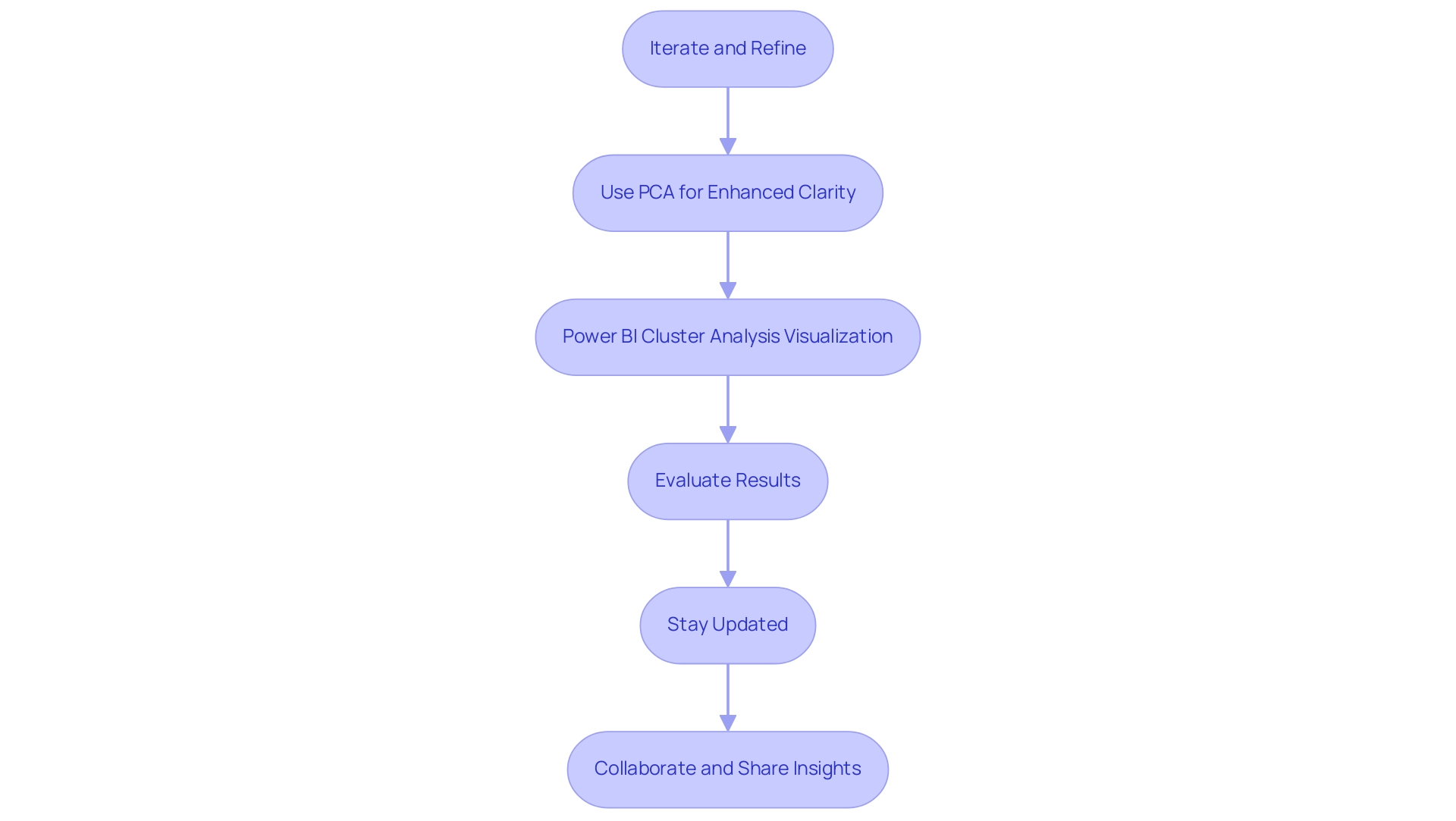Overview:
The article provides a comprehensive step-by-step guide on performing cluster analysis in Power BI, detailing the importance of clustering methods and their applications in extracting actionable insights from data. It emphasizes that effective clustering, supported by techniques such as K-Means and Hierarchical Clustering, enhances decision-making and operational efficiency, as evidenced by case studies demonstrating significant improvements in business performance.
Introduction
In the realm of data analysis, clustering emerges as a transformative technique that empowers organizations to uncover hidden patterns and relationships within their datasets. By grouping similar data points, companies can drive strategic decisions that enhance operational efficiency and foster growth.
With the increasing complexity of data landscapes, mastering clustering methods such as:
- K-Means
- Hierarchical Clustering
- DBSCAN
in Power BI is not just advantageous; it’s essential.
This article delves into the fundamentals of clustering, providing a comprehensive guide on executing cluster analysis in Power BI, exploring various methods, and outlining best practices for successful implementation. By equipping decision-makers with actionable insights and practical strategies, organizations can harness the full potential of their data, paving the way for informed decision-making and sustained business success.
Understanding Clustering: The Basics
Clustering is a powerful method in information examination that supports Power BI cluster analysis by grouping similar points based on specific attributes, enabling organizations to unveil hidden patterns and structures within their collections. As Zyzanski et al. emphasize, the importance of comprehending the characteristics of grouped information is crucial for precise evaluation, clarifying how points correspond with each other within clusters.
By utilizing grouping methods like K-Means, Hierarchical Grouping, and DBSCAN in Power BI cluster analysis, decision-makers can improve their visualizations, making connections between elements clearer and more accessible—essential for fostering insights based on information and operational efficiency. Recent progress in grouping methods, especially in 2024, highlights its increasing importance in information evaluation. For example, the case study titled ‘Intracluster Correlation Examination‘ illustrated that a higher intracluster correlation signifies a more pronounced grouping effect, essential for comprehending the implications of grouping in statistical evaluation.
As Saurav Kaushik, a passionate data science enthusiast, notes,
Clustering techniques are vital for uncovering complex relationships and driving insightful choices.
Furthermore, a testimonial from a leading retail firm showcased how applying grouping analysis in their BI strategy led to a 20% increase in operational efficiency. This foundational technique not only aids in understanding information but also empowers organizations to harness Business Intelligence for actionable insights and make informed, insight-driven decisions effectively.
The advantages of Power BI cluster analysis in Power BI lead to enhanced analytical capabilities, allowing organizations to explore their information landscapes with confidence and precision, ultimately fostering business growth.

Step-by-Step Guide to Performing Cluster Analysis in Power BI
-
Open Power BI Desktop: Begin by launching the Power BI application and loading your dataset, ensuring that you have all necessary data at hand. This step is crucial in utilizing the strength of Business Intelligence to promote informed decision-making and reduce the competitive disadvantage of lacking actionable information.
-
Navigate to the Report View: Switch to the report view, which is essential for creating and manipulating visualizations effectively, helping to alleviate the challenges of time-consuming report creation.
The analysis of data can be greatly improved by utilizing power bi cluster analysis.
-
Select the Visualization Pane: Choose a scatter chart or another visualization that supports clustering, which is crucial for power bi cluster analysis and extracting actionable insights.
-
Add Information Fields: Drag and drop the relevant fields into the X and Y axes of your scatter chart, setting the stage for insightful representation that can highlight operational efficiencies.
-
Power BI cluster analysis can provide valuable insights.
Enable Clustering in Power BI Cluster Analysis: With the scatter chart selected, access the ‘Analytics’ pane and choose ‘Add Clusters’. This function will automatically group your data points based on their similarities, utilizing power bi cluster analysis to enhance data interpretability. Note that HDBSCAN can effectively identify groupings when all features show a within-feature difference corresponding to Cohen’s values of 0. The analysis of data can be greatly improved by utilizing power bi cluster analysis, which can be a valuable standard for your evaluation.
The analysis of data can be significantly enhanced through power bi cluster analysis.
-
Adjust Power BI Cluster Analysis Settings: Fine-tune the settings for power bi cluster analysis, including the number of clusters and the distance metrics. This customization aligns the analysis with your specific objectives in the power bi cluster analysis and improves the accuracy of your findings, ensuring that the conclusions are both relevant and actionable.
-
Review the Results: Analyze the clusters generated in your visualization, interpreting the insights they provide. As noted by Jason Himmelstein,
Selecting the correct data type is important as it influences how your visual calculations can be used in your charts and affects available formatting options for further customization.
This selection is crucial for effective grouping and visualization.
The data insights can be significantly improved through power bi cluster analysis.
-
Reference Case Study: Consider the findings from the case study titled “Statistical Power and Accuracy in Power BI Cluster Analysis,” which defined statistical power in the context of power bi cluster analysis and demonstrated the effectiveness of various methods in detecting true subgroups based on silhouette scores. This case study illustrates the significance of employing robust methods to obtain dependable knowledge, especially in improving operational efficiency through Business Intelligence.
-
Integrate RPA Solutions: To further enhance your operational efficiency, consider integrating RPA solutions such as EMMA RPA and Power Automate. These tools can automate repetitive tasks and streamline your data processes, enabling you to concentrate on evaluation and decision-making.
-
Save Your Report: When you’re satisfied with your analysis, save your Power BI report for future reference and sharing, ensuring your findings are preserved for stakeholders and can drive strategic decisions.

Exploring Clustering Methods in Power BI
Power BI presents a diverse array of clustering methods tailored to meet various analytical needs, playing a crucial role in enhancing Business Intelligence:
- K-Means Clustering: This widely-used method excels in partitioning larger datasets into K distinct clusters based on distance metrics. Its flexibility enables users to specify the number of clusters, making it especially effective for situations where rapid understanding is required. As companies aim to utilize insights based on information for expansion, recent trends indicate an increasing number of publications addressing K-Means grouping, highlighting its lasting significance in information analysis.
The effectiveness of K-Means can be validated using metrics such as the Adjusted Rand index and normalized mutual information, essential for external validation of grouping results.
- Hierarchical Clustering: This technique constructs a dendrogram or tree of clusters, offering a nuanced view of the relationships within the information. It is especially beneficial for smaller datasets where the complexity of relationships warrants a detailed examination.
Expert insights emphasize hierarchical grouping’s benefit in uncovering complex structures that may not be evident through alternative techniques. Tripti Jain, a Business Analyst at Paytm, observes that preparing data for grouping in the context of Power BI cluster analysis involves key steps such as using Power Query Editor to clean data, addressing missing values and inconsistencies, transforming categorical variables into numerical ones, and aggregating data for different analysis levels.
- DBSCAN (Density-Based Spatial Clustering of Applications with Noise): DBSCAN stands out for its ability to identify clusters of varying shapes and sizes, making it a robust choice when the dataset contains noise.
This method is particularly advantageous when traditional grouping techniques may falter, effectively distinguishing between dense regions and noise.
- Python Integration: For those seeking advanced analytical capabilities, Power BI’s integration with Python allows users to utilize additional grouping libraries, such as Scikit-learn. This feature allows the implementation of personalized grouping methods, serving users who need more tailored solutions for their analysis requirements.
Alongside these grouping techniques, the integration of RPA solutions such as EMMA RPA and Power Automate can significantly enhance operational efficiency. These tools automate repetitive tasks, addressing issues such as time-consuming report creation and inconsistencies, thereby allowing teams to concentrate on strategic decision-making. Understanding and utilizing these grouping methods alongside RPA empowers operations efficiency directors to harness the full potential of Power BI cluster analysis.
This, in turn, enables information-driven decision-making that addresses the challenges of time-consuming report creation and inconsistencies, ultimately fostering business growth and innovation.

Preparing Your Data for Effective Clustering
To organize your information for effective grouping and improve operational efficiency, follow these essential steps:
-
Data Cleaning: Start by removing duplicates, addressing missing values, and correcting inconsistencies. Clean information is essential, resulting in more precise grouping outcomes. Techniques such as fuzzy matching, provided by the fuzzywuzzy library, are useful for identifying and removing near-duplicates, further enhancing the quality of information. Recent studies emphasize that efficient information preparation can greatly enhance grouping precision, making it a crucial initial step in addressing technology implementation difficulties.
-
Feature Selection: Identify and select relevant features that contribute to meaningful grouping outcomes. Features that do not add value can obscure important patterns, ultimately leading to misleading results. As Lokesh B. emphasizes,
By scaling features to have similar scales (e.g., mean 0, standard deviation 1 for standardization), you prevent features with wider ranges from dominating distance calculations. This guarantees an equitable comparison of information and improves cluster formation, essential for fostering insights based on information.
-
Normalization: Scale your data to ensure that all features contribute equally to the grouping process. This is particularly vital for distance-based methods, such as K-Means, where the relative scale of features can dramatically influence results.
-
Exploratory Data Analysis (EDA): Conduct EDA to gain insights into your dataset’s distribution and relationships. Visualizations can reveal hidden patterns and guide your feature selection process, ensuring a more informed approach that aligns with your business goals.
-
Define Objectives: Clearly outline your clustering objectives. Comprehending what you intend to accomplish will guide your preparation and analysis, aligning your efforts with your overall business strategy. Implementing strategies that leverage RPA to automate manual workflows enhances efficiency and allows your team to focus on strategic initiatives. Additionally, addressing quality challenges through RPA can help mitigate barriers to AI adoption, ensuring that your information is not only clean but also actionable. The swift expansion of machine learning highlights the significance of power bi cluster analysis in enhancing business understanding and operational effectiveness. Furthermore, leveraging Business Intelligence tools like power bi cluster analysis can transform your cleaned information into actionable insights, enabling informed decision-making that drives growth and innovation.

Best Practices for Successful Cluster Analysis
To achieve successful cluster analysis, consider implementing the following best practices to tackle challenges related to data quality and enhance your AI adoption journey:
-
Iterate and Refine: Embrace the iterative nature of clustering. Experiment with various methods and parameters to identify the optimal fit for your dataset, thereby enhancing the quality of your clusters and addressing inconsistencies that may arise from poor master information quality, such as incomplete or flawed entries.
-
Use PCA for Enhanced Clarity: Implement Principal Component Analysis (PCA) to improve cluster quality by ensuring that the variables are meaningful and less redundant. This approach leads to better-defined clusters, facilitating clearer insights from your data, which is crucial for effective decision-making.
-
Power BI Cluster Analysis Visualization: Visualization is essential for evaluating the clarity of your grouping results. Employ scatter plots and decomposition trees to observe the distinctiveness of your clusters, enabling you to make informed adjustments as needed and mitigate the challenges of time-consuming report creation in Power BI dashboards.
-
Evaluate Results: Implement robust metrics such as silhouette scores and the Davies-Bouldin index to assess performance of groupings. These metrics offer valuable insights into the appropriateness and effectiveness of your grouping solutions. For instance, an adjusted Rand index of 1 indicates a perfect match in grouping, while a value of 0 suggests chance performance. Moreover, the gap statistic serves as a powerful tool, comparing within-cluster dispersion to expected dispersion, guiding you toward the optimal number of clusters and aiding in avoiding both underfitting and overfitting.
-
Stay Updated: The landscape of data evaluation and AI is ever-evolving. Regularly update your knowledge on new grouping techniques and enhancements in power bi cluster analysis to expand your analytical capabilities and improve your grouping strategies. This ongoing learning is essential to address your uncertainty about integrating AI and to counter the common perception that AI projects are time-intensive and costly.
-
Collaborate and Share Insights: Foster a collaborative environment by working with your team to share findings and insights derived from your clustering evaluation. As highlighted by data expert Say, “You could run a few algorithms for determining the best number of clusters and see how your Gaussian model compares.” A consensus on a number of clusters is an indication of strong differentiation in the dataset. Such collaboration will not only enhance your understanding but also facilitate more effective decision-making based on your analysis, guiding you toward overcoming the perceived barriers to AI adoption.

Conclusion
Harnessing the power of clustering techniques in Power BI is essential for organizations looking to unlock the full potential of their data. By utilizing methods such as:
- K-Means
- Hierarchical Clustering
- DBSCAN
businesses can reveal hidden patterns and relationships that drive informed decision-making. The step-by-step guide provided illustrates how to effectively implement cluster analysis, enabling teams to visualize and interpret data with greater clarity.
Preparing data for clustering is equally critical, with best practices emphasizing the importance of:
- Data cleaning
- Feature selection
- Normalization
These foundational steps ensure that the insights derived from clustering are both accurate and actionable. Moreover, incorporating advanced techniques like Principal Component Analysis (PCA) and leveraging automation through RPA can significantly enhance operational efficiency and streamline processes.
Ultimately, the effective use of clustering in Power BI not only aids in data interpretation but also empowers organizations to make strategic decisions that foster growth and innovation. By embracing these practices and staying updated with evolving techniques, decision-makers can drive their organizations toward a future where data-driven insights are at the forefront of operational success.

